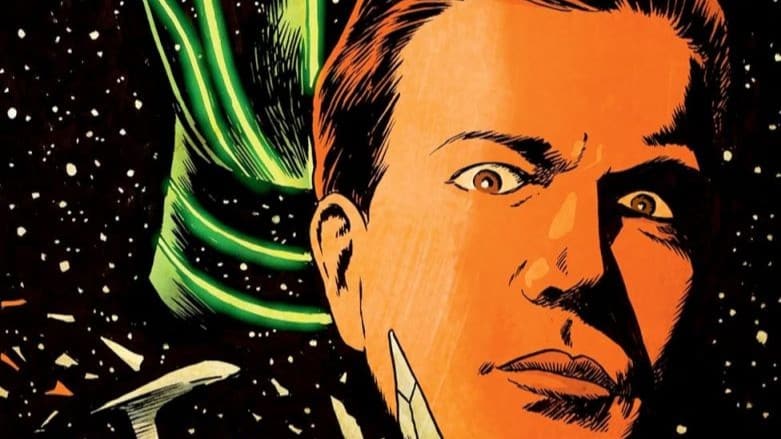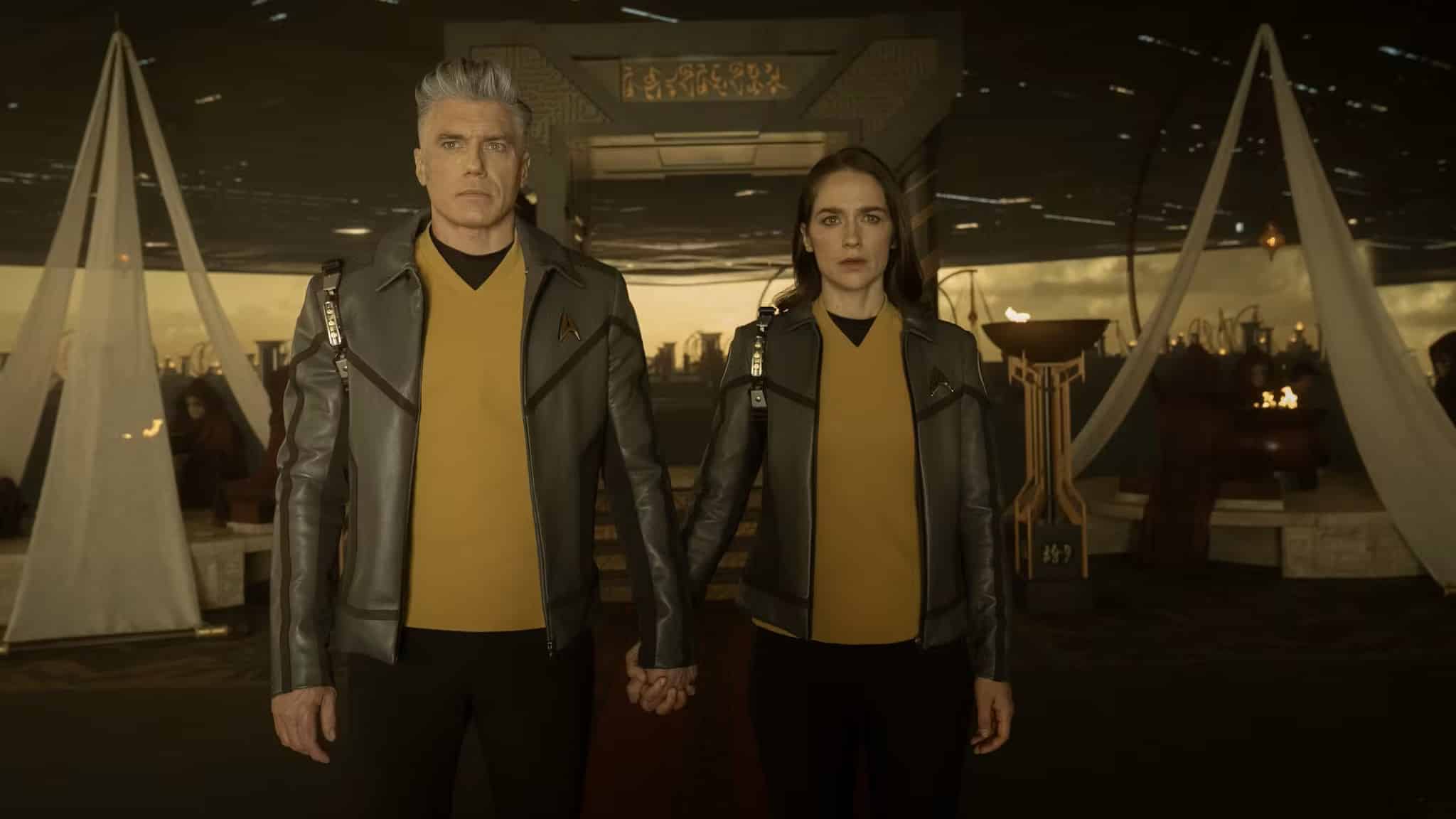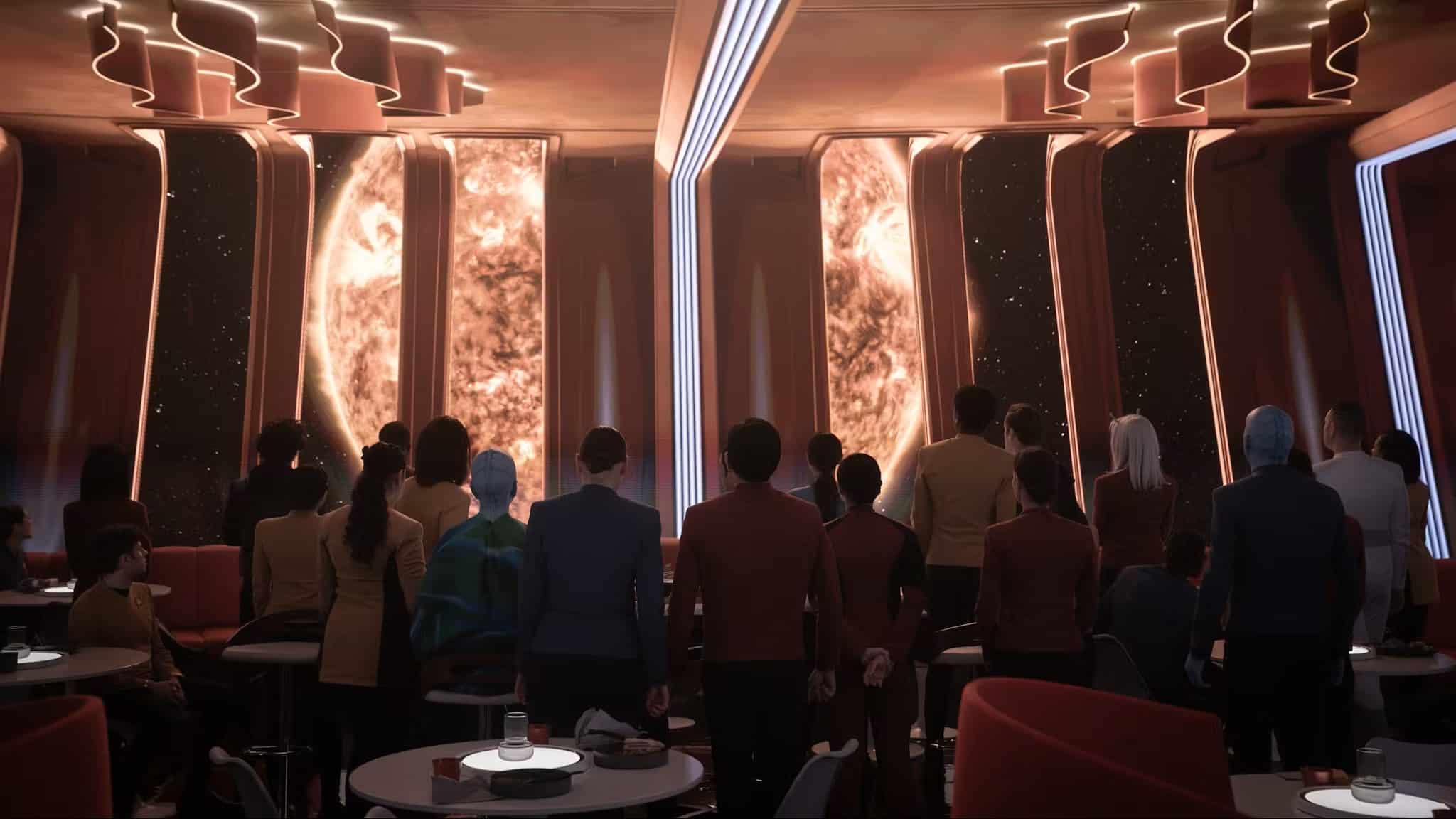In Star Trek #2, Sisko and crew head to the Klingon Empire on the trail of the engineers who built the god killer, and reconnect with an old friend on the way. Written by Collin Kelly & Jackson Lanzing, with art by Oleg Chudakov, colors by Lee Loughridge and letters by Clayton Cowles.
Tony Thornley: Mark! pInaDqu’ tuqlIj wInaDqu’ je! Are you ready to visit the house of Kahless?!
Mark Turetsky: And a glorious Gowron dot ghif to you and to your house.
Welcome To Qo’noS

Tony: Normally, I wouldn’t think much of the first page of an issue like Star Trek #2. Usually it’s just a brief recap and introduction (which is done well by writers Kelly and Lanzing), but they and artist Oleg Chudakov also do a subtle callback to last issue. While the narration clearly shows Ben Sisko is still feeling disconnected, we see his first openly human connection and emotion so far in the last panel on the page. Meanwhile, Ben is centered in the panels leading up to it, and colorist Lee Loughridge colors everything but Sisko in greyscale. While it isn’t EXACTLY the same as the best page of last issue, it’s a great little callback to show how disconnected and inhuman Sisko still feels.
But who is he so thrilled to see? None other than Worf, son of Mogh!
Mark: Worf is one of my favorite Star Trek characters, but I think he suffers from what I like to call The Worf Problem. For a long time he was the single prominent Klingon character in Trek, and because certain writers (namely Ronald D. Moore) used his story to explore and flesh out the Klingon Empire, he became the single most important Klingon of the era, despite starting out as an outsider raised by humans. He’s there at the death of Chancellor K’mpec, he kills Duras in a duel, leaving Gowron to become chancellor, he even goes on to kill Gowron and all-but-appoints Martok as the new chancellor. Oh, and the return of Kahless? He’s there for that too.
What that adds up to is that he should be a walking legend by the end of DS9. And the Federation naming him as their ambassador should be a real power move! He’s the adopted son of the chancellor and killed the previous guy!
Which is why I like that Kelly and Lanzing sidestep that issue in removing most of Martok’s political power. We see a Klingon political machine that depended on implied political norms (Kahless is just a figurehead) discard those norms in favor of political expediency. Sisko marvels that he’s only been away for three years, but the political winds have shifted sharply while he was gone. We’ve seen in real life just how quickly political convention can get set aside in the name of consolidating power, and all because 15 Klingon heads of great houses don’t like the guy who’s currently in charge. So Kahless rules from his gut while Martok hews to etiquette and law and struggles to keep up.
The return of Kahless to the Klingon empire has had no effect onscreen since it happened in TNG’s sixth season (well, outside of my headcanon having to do with Klingon haircuts, see my random musings below). This picks up that discarded plot thread and does something really special with it.
Tony: It’s been so long since I’ve watched these episodes, that I only remembered the broad strokes of this. Which proves why this series is so strong — you either remembered or researched these details and were able to enjoy it on that level. But on my level of general familiarity with this plot, Kelly and Lanzing were able to catch me up just enough that I understood, and enjoyed it.
And hot damn, Kahless was a delight of a character. He reminded me of (don’t slap me for this) Emperor Palpatine here. He was cruel, and clearly not a good guy, but also was fairly canny. Sisko and the crew are here to appeal to Kahless to get access to the Klingon Empire’s shipbuilders on Sarkadesh (which we’ll get into more shortly). Naturally, Kahless says no. Now, my research couldn’t find anything about Sarkadesh. Is it new to this series?
Defiance
Mark: Entirely new. I’m betting the Klingons don’t like talking about the Sarkadesh, as they’re the one planet in Klingon space that the Klingons don’t control, and could kick the Klingons’ asses if they ever felt like it. It reminds me of Dorne in George R. R. Martin’s Fire And Blood: the one corner of Westeros that the Targaryens could never conquer, despite their dragons.
I kind of love that they exist: we know about the Q, and the Prophets, Trelane, the Cytherians and all kinds of godlike beings and civilizations. And here we meet a new one. They don’t have much to do with the greater politics of the quadrant because they simply don’t care to. They’re more interested in creating perfect machines, and so have other things to occupy their time. They’re like Tom Bombadil or the Sublimed civilizations from The Culture. It makes the Trek galaxy a bit stranger and newer, to coin a phrase.
Tony: I liked that too. They almost seem like a bridge between the omnipotent beings like Q, and the extremely technologically-advanced races like the Borg. They also make the Klingons, one of the most exotic species in Trek already, a little weirder and a lot more interesting.
So one thing I really love about Chudakov’s work on Star Trek #2 — he knows how to do a page turn. It’s a bit of a surprise to get a guest artist already (this was probably planned as Rosanas is still wrapping up his Star Wars work), but Chudakov did some great stuff. And my favorite of those page turns is the hero shot of the Theseus leaving Qo’noS. More ship porn, please.
From the hero shot we get a data page/battle hymn about Sarkadesh (very Klingon!), and then the crew beams down to confront them. I expected something much more Klingon and instead, we kind of got the Greys. I liked that surprise. They reminded me of that poor alien kid that once kidnapped Riker, so I kind of wonder if there’s a connection. I mean, the Klingon Empire borders the Romulans, and the Romulans shot those aliens down. He could have been Sarkadesh. Maybe? I’m stretching, I know.
Mark: Good call! They kind of do look like Barash (I knew that without looking it up, I swear!). And I too loved that the “tactical briefing” was a few verses of a Klingon song. The Klingons are always saying “they will sing songs about today.” Which, in Earth anthropology, is how civilizations without writing or with low literacy record history. Setting information to music is a good way to memorize it! It makes the Sarkadesh seem that much more ancient and mysterious here.
Anyway, back on topic, Data pushes back against Sisko’s decision to go to Sarkadesh without permission, as he’s provoking a battle with the Klingons. I’m wondering how much this is a question of trust for Data. He cites his duty as minding Sisko in his current psychological condition. He refers to Sisko’s “potential for extreme reactions.” Would he treat Picard or Riker the same under similar circumstances? Is it his lack of familiarity with Sisko that leads to his distrust?
Tony: You ask two very good, very different questions there. Data would 100% push back in similar circumstances, but in a very different way. Though I don’t think it’s just his lack of familiarity that leads to his distrust — after all, one of his closest friends is standing right next to them showing his trust in Sisko. I definitely think it’s also Data being the ultimate pragmatist, especially with his knowledge that Sisko isn’t quite himself.
Today Is A Good Day To Die!

Tony: The TNG crew put in a great showing through the end of Star Trek #2, didn’t they? While Sisko and the away team — Sato, Data and Crusher — try to appeal to the Sarkadesh (who seem to prefer the name Shapers?), Worf captains the Theseus in battle against a group of Klingon ships (we don’t get confirmation of the class of ship, just that there’s ten of them).
While Data saves the day on the surface, Worf absolutely kicks ass without even firing a shot. This is good Trek storytelling.
Mark: Funny thing is, I think pre-DS9 Worf would have viewed this kind of bluff tactic as beneath the dignity of a Klingon warrior. This is a Worf who’s had enough experience to know that there’s no dishonor in making your enemy shit their own pants, especially when you don’t stand a chance in a firefight. And he can do it because he’s now a major mover and shaker in Klingon politics. He knows the captain of the lead enemy ship, if only by reputation, and so he knows which buttons to push. And it buys the away team enough time for Data to talk the Sarkadesh into not “unmaking” them all.
And the way he does it is through the backhanded means of the humblebrag. He tells the Sarkadesh, and I paraphrase. “Look, I am aware these guys are idiots. They are complete losers and they suck; but guess what, people like them made me. And I am awesome.”
Tony: Absolutely the best paraphrase of a Brent Spiner speech possible. Data’s speech pattern and cadence is something that a lot of writers have struggled with since TNG ended, in my opinion. This so perfectly captured the character in every way. Where Worf is one of your favorites, Data has always been one of mine. Despite his quest to be more human, he’s simply not, and this scene takes that and uses it to his advantage.
Mark: And also I don’t want to fully skip over this, the Sarkadesh can sense Sisko’s connection to the Prophets, and that’s the main thing that offends them. It’s like there’s diplomacy among the higher beings that would be above the comprehension of mere mortals like the Federation or the Klingons. The Sarkadesh say, “everything that falls into [the Prophets’] shadows are entropy’s cursed.” Is Sisko’s experience outside of time and space going to permanently curse him? Is he not the first Emissary? How do they know about this stuff?
Tony: Love a good bit of foreshadowing. I’ve always kind of wondered if the Pah Wraiths and Prophets are two sides of the same coin and that kind of pushes that closer to the forefront. I’m glad we’re getting those sorts of hints alongside the struggles Sisko is having. I keep saying this is good Trek, but it really is.
So we wrap up Star Trek #2 with a little exposition — the god killers coerced the Shapers into building their ship, stating they would die themselves if they didn’t comply. From there, Worf demands his reinstatement to Starfleet — set-up for Defiant! — and we get our next clue: a dagger.
This dagger was really familiar to me, but I couldn’t fully place it. Did you recognize it too?
Mark: It’s a D’k tahg, a Klingon dagger. There was another famous Klingon dagger with blood on it, and that’s the Knife of Kirom, the blade that had Kahless’ blood (and from which he was cloned). That one was a kind of proto-D’k tahg, and this seems to be a modern one. So is the culprit a Klingon? Why would they have a Klingon dagger? The mysteries abound.
As much as I liked Star Trek #2, I have a small nit to pick. After last month’s oversized issue, this regular-length issue felt like it was missing some downtime. I know it’s just the second part of a multi-issue arc, but I really missed seeing Jake in this issue, especially since it starts with Sisko feeling alone and alienated, surrounded by the strangers of his new crew. Trek has a lot of exciting stuff in it, but for me it really excels when there are a few moments with the crew when they’re not doing big adventure things. Again, it’s a small nit, but it felt missing. And it’s a problem with decompressed comics of all kinds, of course.
Tony: It’s an excellent point. I was watching Relics and Schism last night from TNG, and the emotional hook of both episodes came from quieter moments. The most we got was the conversation in Worf’s office and the other one in the briefing room. Beyond what you’re saying about Jake (and I felt similar about Scotty, who got a panel and two or three lines of dialogue in Star Trek #2), I think it would be valuable to get time with Lily Sato and T’Lir. Lily is the first official Andorian main crew member of a Trek series ever, which feels significant as hell, and T’Lir is such a blank slate.
Maybe it’s planned for future issues, but yeah, Star Trek #2 was pretty packed.
Mark: I’m sure it’s all coming, but at this point it’s a bit too much Spider-Man and not quite enough Peter Parker. Still, as I said, it’s only issue #2.
Prepare Yourself for Warp 10 Excitement!
- My headcanon about Kahless and Klingon haircuts is this: the tradition, established in Discovery Season 1 and 2 that Klingons shave their heads in times of war was not followed during the Dominion War on DS9 because it’s a cult of Kahless thing (for evidence of that, see basically all of DSC season 1). Gowron would not want his people to hew to that tradition during the Dominion War because his main political rival at the time was a literal clone of Kahless, so the less influence Kahless has on Klingon culture, the better for Gowron. It also deepens the shaven-headed character of General Chang in Undiscovered Country in his role as a Kirk foil: they’re both men who aren’t ready to give up the war. [MT]
- Is it possible Kahless didn’t want them visiting the Sarkadesh out of fear that the Sarkadesh/Shapers would like the Federation better than the Klingons?
- TNG’ Relics was playing on Pluto TV’s Star Trek channel while we were writing. Love the classics.
- Was it weird that the away team beamed directly down from the bridge? It was weird, right? [TT]
- Experimental prototype ship, baby! [MT]
- [Editor’s Note: Trying to unpack the logic of when and where transporting start/stops lies madness]
- The story of Kahless holding a bridge alone against an army feels very 300 Spartans [Editor’s Note: Or Skurge the Executioner at Gjallebru]. But more Klingon, since they only needed one.
- Next issue’s cover RULES.







